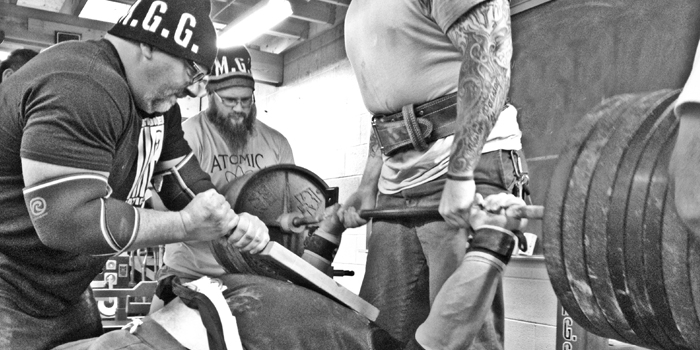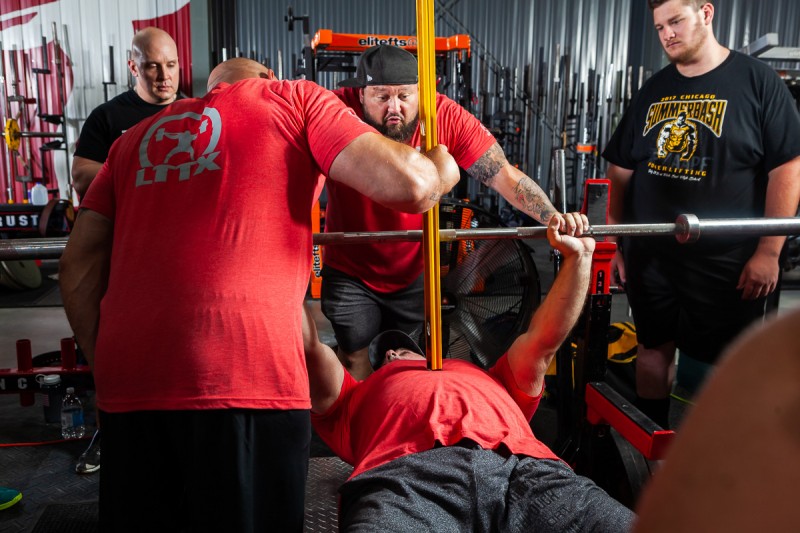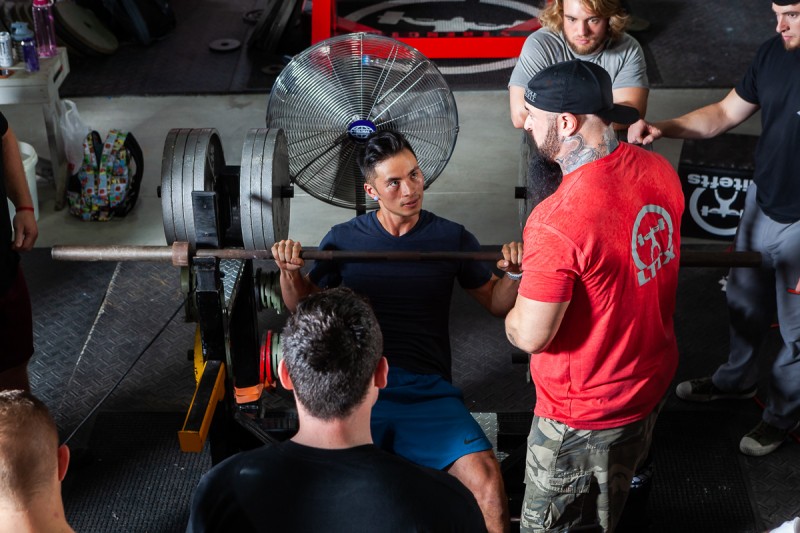
All the ingredients are there, they have always been there, and they will always be there. The ingredients in our sport are the essentials, and if there is a secret, it is just that these ingredients, these essentials, that are there for the taking. To achieve great success in the sport, one must learn the essentials, learn the basics, learn the tried and true, then apply them with virtuosity, consistency, and might and do so for the duration of the journey.
RECENT: Powerlifting and Wrist Straps 101
Often those who find themselves regularly shopping for the latest thing are those that didn’t, to their fullest effort, apply themselves to their latest thing, nor did they apply their fullest effort to the thing just before that, nor the thing prior to that.
These are the lost lifters you see jumping from one diet to another, hopping from one program to the next, randomly adding a band to this odd lift or attaching a chain to that specialty bar in an effort to emulate something they have been sold as a secret or have bought after being told it was a long-lost ingredient to the stew that is strength and power. But the actual missing ingredients are basic and are right in front of them, those being consistency and a full understanding of the basics, the essentials… the key ingredients.
Whatever vernacular you wish to use, call it old-school training, meat and potatoes training, or fundamentals training, the vernacular is a moot point because the bottom line is that tried and true training or the newest and most shiny program are both useless if the lifter does not fully invest the time to educate themselves with the nuance of either.
If you’re a bodybuilder and think those Weider Principles from back in the day don’t make quality muscle and work toward quality hypertrophy because they are now passé, there are a whole load of serious lifters stacked with thick quality muscles who would chuckle at that simplistic statement, as forced reps, drop sets, and supersets are being used successfully by many heavily muscled lifters in today’s sport.

The same rings true for powerlifting. Touting that Prilepin's Chart is out of date is to negate what is arguably the most researched-based training regimen ever applied to the sport of powerlifting.
If Prilepin doesn’t work for the powerlifter and those old-school Weider Principles that were actually created by the successful pioneers of the sport of bodybuilding like Draper, Grimek, Scott, Columbu, Arnold, Vince Gironda, and others don’t work for the aspiring bodybuilder, it is highly probable that the missing ingredients are work ethic multiplied by consistency, multiplied by duration. Truly, there is nothing to reinvent, as all the tools are there in the lifters’ toolbox. They have been there and will remain there, whether used or neglected.
Sometimes I feel like a broken record as I find myself saying or thinking the same things over and again when I hear, “Yeah, I tried to program this or that or method x, y, and z, and it didn’t work for me. I just don’t think those are good programs.”
In my mind, I just think to myself, “You spent half your workout on the phone, and when you finally put that thing down, you did another set with the same incorrect technique as the set before, and the set before that, as well as the sets for the previous six months.”
RELATED: General Criteria to Consider When Writing a Program
In all honesty, if a lifter can’t stuff their phone away into their gym bag for a lousy hour or two in the gym and let their mind completely be immersed and completely dedicated to the time under the bar, the time in-between sets (which is critical) and the time as they get ready to lift again, then no program, no diet, no coach, no template, no gym, no lifting partner is going to get them where they aspire to be.
There is nothing to reinvent program- or training-wise, and there is nothing to reinvent when it comes to mindset. And it is that, mindset, which is something that you don’t see advertised because it is tough to make money on a mindset because the mindset is intrinsic to the lifter and far more difficult and complex than slapping together a training regiment or nutritional template.
The bottom line is the training part is what we love, the nutritional aspect is what fuels our training, and the time recovering is where the growth begins, but it is our mindset that, when absent, allows for these components to flail in the wind like a tattered flag abandoned on its pole.
Take three different lifters from three different eras: Frantz, Coan, and Thompson. They all had different training programs and yet the thread that they all had and/or have in common is a mindset that when applied to their specific training routine equated to great powerlifting. I have said it before, and I will say it again, I can’t imagine the great Ed Coan doing a set, then spending 15 minutes scrolling up on a phone, then trying to get his mind right again for his next set. Nor could I see any of these three lifters shopping for the latest program as the reality is any quality program will get a lifter strong and powerful if that lifter has an ironclad mindset and has not only learned the essentials, the foundation, the fundamentals, and the ingredients and has applied them to every set and rep for the duration.
For a lifter who is struggling with their individual lifts or total as a whole, it is absolutely critical that, before they look at their program or the type of bench shirt or knee wraps they wear or some other variable that can be bought or purchased or downloaded or borrowed from another lifter, they deeply vet their mindset and commitment and their approach to not just each training session but to each set, every rep, and that absolutely critical yet often negated time in-between each set.

That time in-between sets is like that baton exchange between two sprinters in the relay race. It is the link between two things that, if handled poorly, compromises the whole. A poor baton exchange between the third to the fourth leg of the 4x100 can negate the huge lead provided by the first three sprinters in that brief moment in time during that baton exchange between the final two sprinters. Time in-between sets is rarely, if ever, mentioned, but how it is utilized is a critical ingredient to that day’s training.
We can’t always control the variables in a workout. Some days you are at work, and the meals just don’t happen due to meetings and the like, and the workout can suffer. Some nights you are up late with a sick child, spouse, friend, or pet, and your lack of sleep can make the workout suffer. These are things we can’t always control, but what we can absolutely control that time in-between.
The time spent in-between sets either on that workout-destroying phone, or that time wasted BSing instead of keeping one’s mind right for the next set is so often overlooked, and it is one of the easiest aspects of our training to control, and it is one of the most critical.
READ MORE: 3 Things You'll Find in My Mental Health Toolbox
That time in-between sets has existed for as long as there have been sets and reps. There was time in-between sets for Paul Anderson, there was time in-between sets for Robby Robinson, and there is that critical time in-between sets for you. And as sets and reps are the work that leads to the results, the time in-between sets the stage for the next successful set of reps — or the unsuccessful set of reps.
We look for data in aspects of our training programs, and data is a powerful tool. The data about the time in-between is very clear but often overlooked. It is akin to recovery after training. So much value goes into the time we have weight on our back and in our hands, but it is that time outside of the gym, where sleep and nutrition serve our training because, without recovery, the training greatly suffers.
As is the case with the time in-between sets, as it is the time to both mentally and physically digest what we just did, and then to prepare to build from there. Time in-between sets that is spent letting our minds stray from the training at hand is a mistake, just like failure to eat a good meal after a serious training session.
The more studies that come out about cell phone use and exercise, the stronger the evidence is stating that picking up that phone in-between sets has negative causation with regard to training intensity. It is proof gained at the expense of many well-intentioned workouts that demonstrates the power of the time in-between.
The good news is these studies indicate that the cell phone for the use of listening to music while working out does not hamper training, provided there is just listening and not that scrolling and inviting that world to invade your time in-between sets, as that is the death of training, and the body of research showing this is growing exponentially.

Think about the last great rock concert you’ve attended. Reflect on how the band started with a killer opening song and each song seamlessly blended into the next, with the audience on their feet the entire show. Finally, the last song of the night comes and it is the icing on the cake, the best song from the album (remember albums?) making the entire show phenomenal.
Now, imagine that same band, same audience, same venue, but after each song, the band pauses for 10 minutes and scrolls through their phones on stage. That inertia, that musical crescendo would never build as that momentum coming from song one — or let’s call it, set one —would die prior to the next song, as the band’s momentum would have been stopped in its musical tracks. It would stop in its musical tracks as the band sat and scrolled, creating a disconnect between songs instead of cultivating a musical bridge with the time in-between them that would have served to bring the audience to a fever pitch as each and every song would build onto the next.
The time in-between is the mental and emotional connective tissue required for cohesion and for each set to grow in its intensity. I have seen lifters come to our gym, lifters with great potential and a fire in their belly, but who end up turning into nothing much more than a dimming ember once they started murdering their in-between time with the phone. It is that slow demise of a lifter that is painful to watch as their obsessive, addictive use of a device erodes away a potential that will never be fulfilled. The phone kills it. Training with an unfocused and undisciplined lifter who just talks about his or her weekend kills it.
WATCH: Table Talk — How Much of Your Workout Should Be Accessory Work?
So many things can bludgeon to death that time in-between, and you must hold that time as critical as your sets and reps must be tied together. They must all flow, and when one part is lagging, it all suffers, as when we are talking about the various parts of a training session, we are ultimately talking about symbiosis. And it is the power of the symbiotic that allows for exponential progress during the training cycle.
The time in-between sets matters. Just hitting the sets and reps hard is not enough as training involves synergy and killing that during the time in-between sets by disengaging the mind will always serve to produce sub-par results. An hour of connected sets, of training in a synergistic fashion with intensity and a mind-body connection, will always produce results that are better than a three-hour training session comprised of gaping holes and a drop of focus in-between the sets.
The quantity of time in the weight room matters, but only when the quality of training is there first. The body is not forced to grow bigger and stronger by merely one’s duration in the gym; the body is forced to grow bigger and stronger by the productive muscular damage inflicted on it and that it must recover from, and a connected time in-between sets equates to creating more of this productive muscular damage.
The time in-between sets is an ingredient that is rarely, if ever, discussed as it just exists. There is no template to follow; it is simple and pure, but until it was contaminated with, bombarded with, or we can safely say, destroyed by the use of the smartphone in the weight room. It never had to be discussed because it is so simple it can be ignored, but make no mistake about it, connecting the mind and the body and connecting each progressively heavier set and mentally digesting each prior set, the time in-between is an essential ingredient. It always has been and always will be, since the first dumbbell was hoisted and then put back down.
Don’t let this seemly innocuous ingredient come up missing in your training. Because the bottom line is when it comes to the time in-between sets, the best have always used it, and the rest have always squandered it.











3 Comments